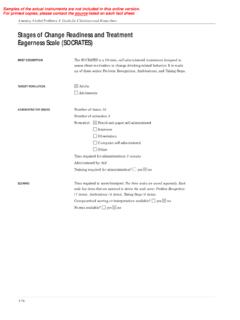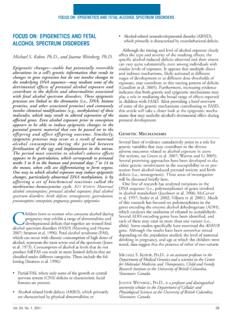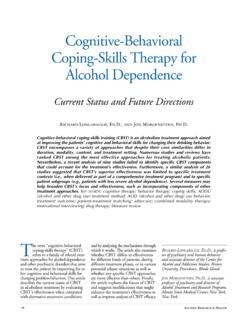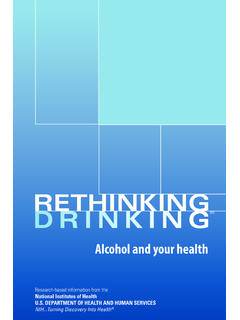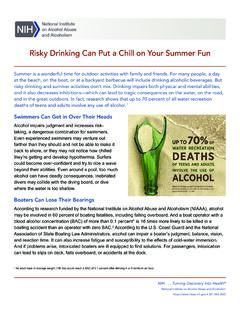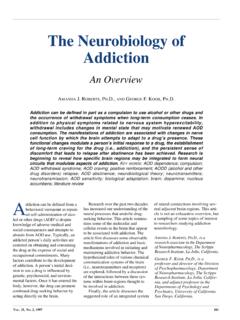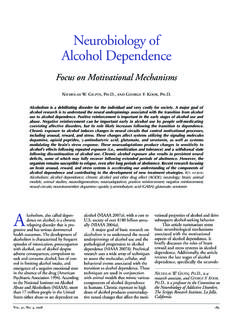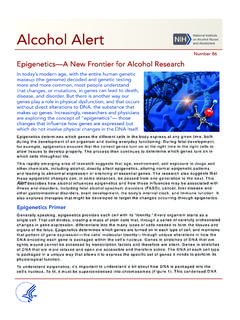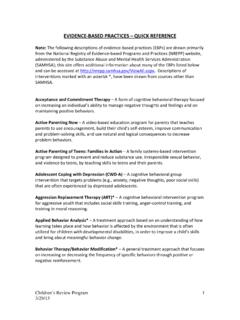Transcription of Global Appraisal of Individual Needs (GAIN)
1 Samples of the actual instruments are not included in this online version. For printed copies, please contact the _____. source listed on each fact sheet. Global Appraisal of Individual Needs ( gain ). Global Appraisal of Individual Needs ( gain ). BRIEF DESCRIPTION The gain is a series of measures (screener, standardized biopsychosocial intake assessment battery, followup assessment battery) designed to integrate research and clinical assessment. With 99 scales and subscales, it is designed to measure the recency, breadth, and frequency of problems and service utilization related to substance use (including diagnosis and course, treat . ment motivation, and relapse potential), physical health, risk/protective involvement, mental health, environment and vocational situation.
2 The sample pages show the gain 's substance problem index (SPI), a dimen . sional measure of problem severity for the participant's lifetime, past year, and past month; it can also be used to measure change over time and to categorize participants (based on report) in terms of abuse, dependence, and course specifiers (supplemental questions can also be used to break out problems/diagnosis by substance). TARGET POPULATION Adults Adolescents (over 11 years). Groups for which this instrument might be especially helpful? Adults in outpatient, intensive outpatient, drug court program (IOP/OP. step down), methadone, short-term residential, long-term residential, TASC-criminal justice residential program, pregnant/postpartum women's program, dual diagnosis, and homeless subgroups at intake to substance abuse treatment and for quarterly followup (used up to 24 months later).
3 Adolescents in outpatient, intensive outpatient, short-term residential, therapeutic community, and residential aftercare programs at intake to substance abuse treatment and for quarterly followup (used up to 30 months later). Adults and adolescents on probation, in employee assistance programs or student assistance programs (not necessarily in treatment) as part of screening. 417. Assessing Alcohol Problems: A Guide for Clinicians and Researchers ADMINISTRATIVE ISSUES Number of items: 1,606 for full version (but set up modularly). Number of subscales: 99 core scales (more developed by other investigators). Format(s): Pencil-and-paper self-administered Interview (structured). Observation Computer self-administered (forthcoming).
4 Other (describe) Computer-assisted interview (by staff) Time required for administration: 60 to 120 minutes Administered by: Self or clinical interviewer Training required for administration? yes no Comments: For information on training and certification see SCORING Time required to score/interpret: 6- to 8-page computer-generated profile generated after data entry or online administration in 2 minutes and 2-page hand-scored profile in about 10 minutes Scored by: Administrator, clerk, or computer Scoring key? yes no Computerized scoring or interpretation available? yes no Norms available? yes no Instrument normed on subgroups? yes no Which groups? Adults entering outpatient, IOP, drug court, methadone, short-term residential, long-term residential, TASC-criminal justice residential program, and pregnant/postpartum women's program, as well as adult subgroups with co-occurring mental diagnoses (internal, external, both), and who are homeless.
5 Adolescents entering outpatient, intensive out . patient, short-term residential, therapeutic community, long- term residential and residential aftercare program, as well as screener (subset of items/scales) on samples of adolescents entering in student assistance programs, detention, and probation/parole. Requests can be made for runs on additional subgroups. Comments: Norms based on over 3,000 adolescents from 61 treatment programs around the country in major cities, small urban areas, rural areas, and Indian reservations 418. Global Appraisal of Individual Needs ( gain ). PSYCHOMETRICS Have reliability studies been done? yes no What measure(s) of reliability was used? Test-retest Split half Internal consistency Have validity studies been done?
6 Yes no What measures of validity have been derived? Content Criterion (predictive, concurrent, postdictive ). Construct CLINICAL UTILITY OF INSTRUMENT The gain is a standard biopsychosocial instrument designed to integrate the assessment for both clinical ( , diagnosis to APA's DSM-IV-TR, place . ment to ASAM's PPC-2, treatment planning to JAHCO, and program planning to CARF) and program evaluation ( Needs assessment, clustering, fidelity, out . comes, and benefit-cost) purposes. The instrument and computer applications are modularized to support the use of subsections and/or scoring by clinicians for immediate use. Starting in 2002, it has also started issuing both statistical and narrative reports to facilitate interpretation and referrals related to diagnosis, further assessment, placement, and treatment planning.
7 RESEARCH APPLICABILITY Measures have been mapped onto major clinical, epidemiological, and economic databases and standards, reviewed by expert panels, and have been demonstrated to have excellent reliability, validity, and sensitivity to change by both the developers and multiple independent investigators. Key outcomes have also been valued to support benefit-cost analysis of treatment programs. SOURCE, COST AND COPYRIGHT ISSUES Copyright: yes no Cost: $ license fee per p roject for use of Beta version Source: Michael Dennis, Senior Research Psychologist Chestnut Health Systems 720 West Chestnut Bloomington, IL 61701. Phone: 309-827-6026. E-mail: Web site: Cost/Source of computerized scoring: Part of $ license fee per project for use of Beta version 419.
8 Assessing Alcohol Problems: A Guide for Clinicians and Researchers SOURCE REFERENCE Dennis, M., Titus, J., White, M., Unsicker, J. & Hodkgins, D. (2002). Global Appraisal of Individual Needs ( gain ): Administration Guide for the gain and Related Measures. Bloomington, IL: Chestnut Health Systems. [Online]. Available: SUPPORTING REFERENCES Buchan, B., Dennis, , Tims, F. & Diamond, (in press). Marijuana use: Consistency and validity of self report, on-site testing & laboratory testing. Addiction. Babor, , Webb, C., Burleson, & Kaminer, Y. (2002). Subtypes for classifying adolescents with marijuana use disorders: Construct validity and clinical implications. Addiction, 97 (Suppl. 1), 58. Dennis, , Dawud-Noursi, , Muck, R.
9 & McDermeit, M. (2002). The need for developing and evaluating adolescent treatment models. In Stevens, & Morral, (Eds.), Exemplary Models for Adolescent Substance Abuse Treatment in America. Binghamton, NY: Haworth Press. Dennis, , Titus, , Diamond, G., Donaldson, J., Godley, , Tims, , Webb, C., Kaminer, Y., Babor, T., Roebuck, , Godley, , Hamilton, N., Liddle, H. & Scott, (2002). The Cannabis Youth Treatment (CYT) experiment: Rationale, study design, and analysis plans. Addiction, 97 (Suppl. 1), 16. Godley, , Godley, , Dennis, , Funk, R. & Passetti, L. (2002). Preliminary outcomes from the assertive continuing care experiment for adolescents discharged from residential treatment. Journal of Substance Abuse Treatment, 23, 21-32.
10 Dennis, , Scott, , Godley, & Funk, R. (2000). Predicting outcomes in adult and adolescent treatment with case mix vs. level of care: Finding from the drug outcome monitoring study. Journal of Drug and Alcohol Dependence, 60 (Suppl. 1), s51. Dennis, , Scott, , Godley, & Funk, R. (1999). Comparisons of adolescents and adults by ASAM profile using gain data from the Drug Outcome Monitoring Study (DOMS): Preliminary data tables. Bloomington, IL: Chestnut Health Systems. [Online]. Available: 420.
